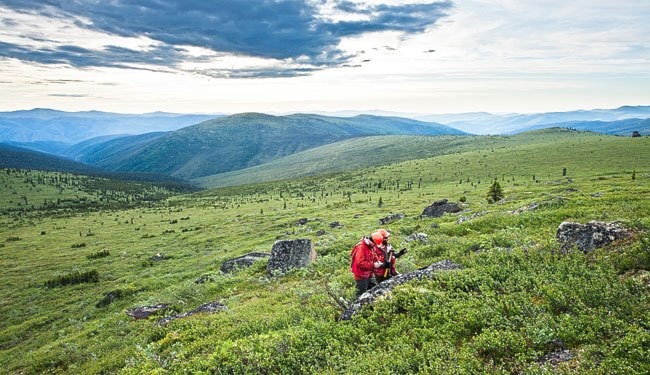All but one of the Yukon’s hard rock mines have shuttered. Annual surveys from the Fraser Institute have shown the territory declining in investment attractiveness. And this week, three Yukon First Nations filed a court challenge over Bill S-6, which threatens to damage the relationship between the government and First Nations over resource development.
But amid all the gloomy news, Kaminak Gold Corporation’s Coffee Gold project may be the glimmer of hope the Yukon’s mining industry so desperately needs.
Last month, Kaminak announced a new $22.5-million investment that comes in part from a new shareholder, billionaire investor Thomas Kaplan’s Electrum Strategic Opportunities Fund L.P.
In a time when investors “are looking for reasons not to invest, not for reasons to invest,” according to Kaminak President and CEO Eira Thomas, the funding is a major vote of confidence for the junior mining company.
Thomas said the new funding should see the Coffee project through its permitting phase, which will begin next year. Kaminak hopes to have all of its permits in place by 2018, and to start production by 2019.
The Coffee project’s strength lies partly in the fact that the gold deposit is high grade, lies near the surface and is relatively easy to recover. Kaminak plans to build a heap-leach mine, which involves piling the ore on a pad and irrigating it with a solution to dissolve the gold. The gold then leaches out and is collected and formed into semi-pure bars, which can be flown out and delivered directly to customers.
“Coffee is a very straightforward, simple project,” said Thomas. The mine won’t require a mill or a tailings pond, and the gold won’t need further refining once it’s flown off the site.
Last year, Kaminak completed a preliminary economic assessment of the project, and found that it was economically viable at a gold price of $1,250 U.S. an ounce.
Since then, the price of gold has dropped to below $1,200 U.S. an ounce, but the Canadian dollar has dropped as well, down to less than 80 cents on the American dollar. Because gold sells in U.S. dollars, that means the economics of the Coffee Gold project are still looking good. Thomas said Coffee will be viable to as low as $1,000 U.S. an ounce.
But it’s not just geology and economics that make the Coffee project attractive.
Thomas said one of the first things she did when she took over as CEO of Kaminak in 2013 was to formalize the company’s relationship with the Tr’ondek Hwech’in First Nation.
“We’ve really enjoyed working with (Tr’ondek Hwech’in),” she said. “They certainly are a First Nation that understands the importance of economic development for their people.”
She said that Kaminak has been working on a project with the First Nation government and the Yukon College to provide training to First Nation citizens in environmental monitoring. With the support of the company and the First Nation, the college has offered two courses so far - an introduction to environmental monitoring and a field course on plant restoration that was held partly at the Coffee site.
Thomas said Kaminak has hired about six environmental monitors from Tr’ondek Hwech’in who monitor and audit activities on the site, and she wants to help the college offer more courses.
“The idea is that longer-term, these courses will work toward an accreditation which would allow these students to go on and pursue a post-secondary degree,” she explained.
Kaminak recently announced plans to build an access road from Dawson City to the mine site, which Tr’ondek Hwech’in Chief Roberta Joseph said would “maximize business opportunities” for First Nation citizens and “provide great benefit for the entire town of Dawson City.”
Thomas is not one to bemoan the hurdles for mining companies trying to break ground in the Yukon. She acknowledges what she calls “the headwinds” - the cold winter months when work can grind to a halt, the patchy infrastructure, the oft-fraught relationship between the government and First Nations - but she said the territory has a number of advantages, too.
“What impresses me most about this jurisdiction is the will,” she said. “There’s a strong consensus that mining is important, and that’s such an important underlying factor.”
And Thomas would know. She’s no rookie to northern mining. In fact, she led the exploration team that discovered the richest kimberlite in the world, now one of the pipes at the Diavik diamond mine in the Northwest Territories.
She said she still wears earrings made of Diavik diamonds nearly every day. She has two pairs, which she plans to pass on to her two daughters.
But she came to work in the Yukon for the first time in 2013, after deciding that the Coffee project had the potential to become a “world-class gold mine.” Working here also allows her to take quick flights to and from Vancouver, where her family is based.
It’s not an easy lifestyle. “I spend a lot of my life on planes, and that isn’t always desirable,” she said. But the mining bug hasn’t really left her since she picked it up as a child from her father, who worked in exploration himself.
“It’s about defying the odds and hopefully using your brain and using the science to make a discovery that could be the one.
“It’s something that stays with you for a long time.”
For now, though, Thomas is determined to see the Coffee project through. By the looks of things, she may not have to wait much longer.
Contact Maura Forrest at
maura.forrest@yukon-news.com
